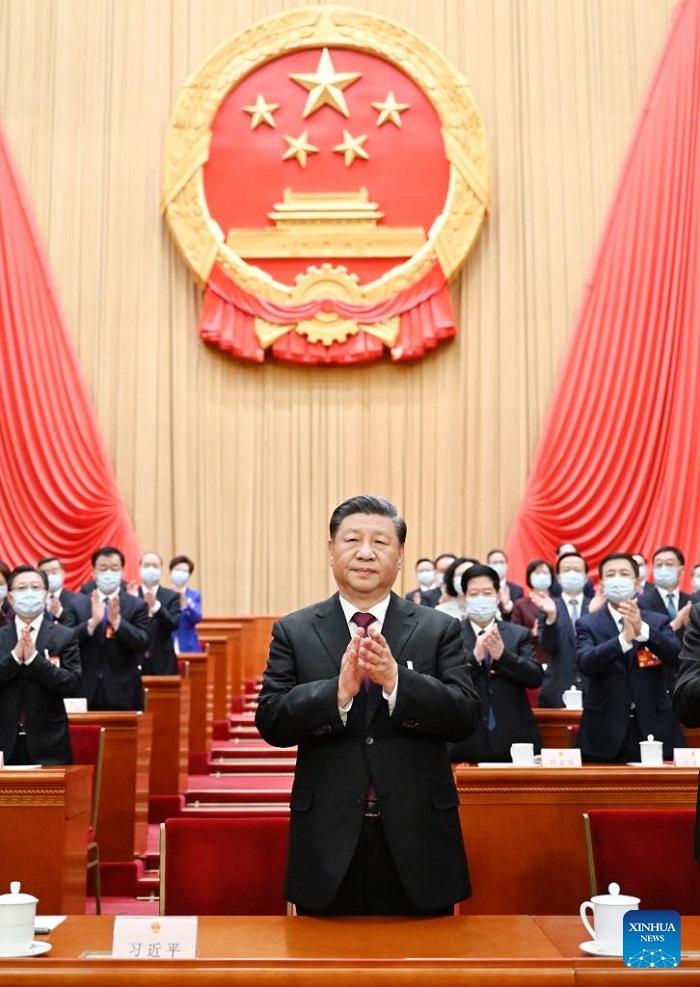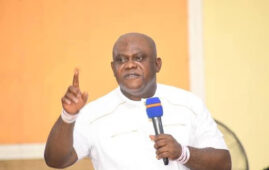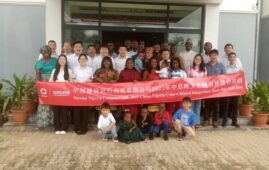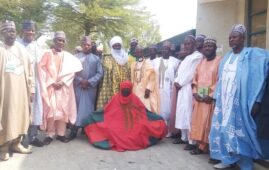



On Friday March 10, China’s parliament in their own wisdom elected Mr. Xi Jinping as president for third term an action that will see the great reformer and economic miracle worker pilot the affairs of the second largest economy in the world for another five years. This happened during a session of China’s National People’s Congress (NPC) at the Great Hall of the People in Beijing.
Xi was re-elected unanimously by the nearly 3,000 delegates to the National People’s Congress, which is holding its annual meeting in Beijing. After the announcement, Xi bowed to the delegates as they applauded.
Taking an oath of office with his right hand held up in a fist, Xi said he would be loyal to the constitution and the “motherland”, and “work hard to build a prosperous, strong, democratic, civilized, harmonious and beautiful modern socialist country.”
Recall that at a Communist Party congress in October, Xi clinched a norm-bending third term as party chief and surrounded himself with egg heads and great thinkers that will help rejuvenate the nation’s economy. His victory was welcomed by Chinese nationals all over the world and non Chinese who have benefitted from his modest diplomatic engagements with nations of the world.
Analysts around the globe were quick to point out that Xi’s reelection was a reflection of peoples’ wish given his far reaching reforms that have greatly benefitted Chinese populace. They ranked his contributions to Chinese growth to that of Chairman Mao Zedong, who founded the modern China and Deng Xiaoping, who guided China’s economic opening as paramount leader for around 20 years until his death in 1997.
It is important to know that poverty alleviation and improvement of the People’s Well-being have taken preeminence upon Xi’s arrival as Chinese president. Since Xi’s coming, China has scored a decisive victory against poverty, employment conditions have been improved, urban and rural residents find their incomes growing faster than the economy, a social security system has been built to cover the whole people, and education is making smooth progress. The Chinese people now have a stronger sense of security, benefit and happiness.
Common prosperity is now fundamental principle of socialism with distinctive Chinese features. The new era is one for achieving common prosperity. Since 2012 the central leadership headed by Xi Jinping has been engaged in a “war against poverty. When inspecting the poverty-alleviation and development in Fuping County, Hebei Province, in December 2012, he (Xi) pointed out, “We cannot say we have realized a moderately prosperous society if the rural areas, especially the backward parts of the countryside, are left behind.” During an inspection tour of Shibadong Village in Hunan Province in November 2013 he coined the term “targeted poverty alleviation,” and stressed that this work must be based on local conditions.
To conquer extreme poverty, China under Xi has mobilized manpower, material and financial resources on an unprecedented scale. Special policies have been devised to help the regions suffering extreme poverty: Tibet, four prefectures in southern Xinjiang (Hotan, Aksu, Kashi, and the Kirgiz Autonomous Prefecture of Kizilsu), the areas in Sichuan, Yunnan, Gansu and Qinghai with large Tibetan populations, and the prefectures of Liangshan in Sichuan, Nujiang in Yunnan and Linxia in Gansu. |
From 2013 to 2017 the central government funding for poverty alleviation programs totaled 278.7 billion yuan, up 22.7 percent year-by-year on average; and the provincial spending was 182.5 billion yuan, up 26.9 percent year-by year on average. By October 2017 the developed areas and central Party and government institutions had dispatched 122,000 people on poverty alleviation missions in the poor regions, and provided more than one trillion yuan to these regions. A total of 2.778 million people had’ been sent to work in the villages.
Thanks to the endeavors of the whole country and the whole Party, the poverty-stricken population had dropped from 98.99 million in late 2012 to 16.6 million in late 2018, and the poverty headcount ratio was down from 10.2 percent to 1.7 percent. From 2013 to 2018 the annual growth of disposable income of rural residents in poor regions was 12.1 percent, which was 10 percent if adjusted for inflation, or 2.3 percentage points higher than the average growth in rural areas as a whole. All credits to good initiatives promoted by President Xi.
In March 2019 President Xi Jinping called on the whole country to rise to the challenge of poverty. In April he demanded more efforts to tackle the prominent problems and ensure that the poverty alleviation goals be achieved and the task of building a moderately prosperous society in all respects fulfilled as scheduled.
China under Xi has implemented the employment-first strategy since 2012. People are encouraged to start businesses as a way to stabilize the job market. From late 2012 to late 2018 the total number of people employed increased from 767.04 million to 775.86 million, and the year-end registered urban unemployment rate dropped from 4.1 percent to 3.8 percent. New urban jobs exceeded 13 million every year from 2013 to 2018.
The reform of the income distribution system is making steady progress. Salaries roughly grow in step with productivity, the proportion of pay in the primary distribution of social wealth increases, and the gap between industrial Sectors, regions and social groups is narrowing.
China’s social security system has been improving in fairness since 2012. In 2014 the social pension schemes for rural and non-working urban residents were merged under unified national management. Public institutions and government offices began to introduce a basic pension scheme similar to that of enterprises, ending the dual pension scheme.
In 2016 the basic insurance schemes for rural and non-working urban residents were unified, Reforms have expanded the coverage of social security, with an increasing number of people joining the pension, medical, unemployment work-related injury, and maternity insurance schemes.
President Xi also brought increased development in educational system that met the aspiration and expectation of Chinese peoples and millions of non Chinese nationals schooling in China. Since 2012 China’s spending on education has kept increasing, and the development of education is becoming balanced, making the people feel the benefit of education.
In December 2013 a national program was launched to improve the conditions of schools in poor areas that provide nine-year compulsory education. By late 2018 some 220 million square meters of school buildings had been expanded or built and teaching devices worth 106.6 billion yuan had been purchased, benefiting nearly 220,000 schools in more than 2,600 counties.
In July 2016 the State Council decided to accelerate the integrated development of urban and rural compulsory education in the counties, demanding that unified standards be adopted for their school buildings, staff sizes, per-student funding and basic equipment; that the policies be fully executed to exempt all students receiving compulsory education from paying tuition and other fees, supply free textbooks to rural students, and grant living allowances for boarders from financially disadvantaged rural families; and that by 2020, the schools providing compulsory education in the counties shall have balanced development, and equal access to basic public education services be realized in both urban and rural areas.
It is on record that from 2015 to 2018 the country’s 338 counties had spent a total of 254.4 billion yuan on compulsory education, and enrolled about 220,000 new teachers; built 1,598 new schools, and expanded or renovated nearly 40,000 schools; and purchased new teaching devices worth 119.4 billion yuan and 220 million copies of new books. By the end of 2018 some 2,717 or 92.7 percent of China’s counties had passed the evaluation of balanced development of education.
President Xi during the Corona virus pandemic with Great Spirit of determination and commitment gave the virus a bloody nose. After the outbreak began, the Party Central Committee under Xi made containment the top priority. Xi, prioritizing the health and safety of the people above all else, personally took charge and planned the response, and called for confidence, solidarity, and a targeted response based on science.
President Xi Jinping presided over 4 sessions of the Political Bureau of the Party Central Committee and 14 sessions of its standing committee, as well as multiple other important Party meetings. The central leadership demonstrated keen insight, practiced decisive decision-making, offered sound guidance, and met the challenge with composure as they made meticulous plans for protecting Wuhan and Hubei, formulated major strategies in light of the evolving situation, and led the whole Party, all of the armed forces, and the entire nation in rapidly launching an all-out people’s war against the epidemic.
Under the firm leadership of the Party Central Committee, the Chinese people came together in this difficult time, providing overwhelming support to those in need and putting up a strong line of defense against the epidemic. Xi rallied China’s medical worker, with 540,000 local medical workers from Hubei and Wuhan fight the virus at close quarters while more than 40,000 medical workers and 346 medical teams from across the country rushed to the front lines without hesitation.
Private businesses and hospitals, charities, nursing homes, and welfare institutions actively pitched in, countless Party members and officials led by example, and police officers and servicemen and women of the PLA and the People’s Armed Police fought bravely on the front lines.
China largely contained the spread of the virus in just over a month’ line, reduced the daily number of new local cases to the single digits in roughly two months’ time, and achieved decisive success in the battle to protect Wuhan and Hubei in approximately three months. All these efforts at making China the greatest nation in the world have greatly endeared President Xi to Chinese populace.
In the final analyses, experts in China affairs have expressed optimism that Xi’s new assumption of control of the party-state will see China escape the middle-income trap and strive toward the goal of “common prosperity” — primarily enhance the Chinese middle class. That will in turn potentially drive and stimulate China’s “three engines of growth,” namely, investment, consumption, and foreign trade, each of which has faced challenges.


OPM runs 29 free schools, two.


The fact remains that China’s use.


The people of Zarma/Zabarmawa are believed.


It was shortly before noon on.


After the adoption of UNSCR 2250.
As part of countdown to successful.
Leave a Comment